Golem has been one of those games where I have been almost triggering the purchase for months. I had it in my checkout cart multiple times and then removed it. I held it in my hands at my local game store, pondered it for a couple of minutes, and ultimately put it back on the shelf. Golem has been a game of many questions for me: The theme sounded interesting, but will I like it? The gameplay sounds mechanical, is it too dry? And why, why does it have to have such a grim box cover? Fortunately, I received a gift voucher from my colleagues for my birthday and that was just the incentive I needed to finally hit the buy-button.
And what can I say: it’s good! Well, that’s hardly a spoiler considering the authors this comes from. The more interesting question is: is it good enough to warrant a place in my collection? Shelf space is at a premium right now as Foundations of Rome and Castles of Mad King Ludwig: Collector’s Edition have caused quite a substantial overspill pile in my living room area. So I need to cull a few games and be careful what to keep and what to let go. Do I need this when I have the Grand Austria Hotel Deluxe Editionand many other good euros already?

Setup
For its shape, Golem’s box packs quite a punch and setup takes its time. The central piece is the main board showing three districts, each a row of buildings onto which cardboard tiles are placed. These tiles stay fixed during the whole game and represent the bonuses that are associated with every single building. There are a few more tiles than buildings, so the selection and order of bonuses will be different from game to game.
The first row (red) focuses on getting clay, constructing golems and purchasing golem related upgrades. The second row (yellow) focuses on money and gold, resources required to produce artifacts, as well as the upgrades related to artifact production. The third and final row (blue) focuses on gaining knowledge (which for some reason I always call “magic” in my head), buying books and – you guessed it – the upgrades related to books. In each district, there is a small alley above the action tiles where each player places one of their students, and below is the larger area where the golems will walk through the city. Also on the main board is an area for four character cards, each representing one of the only four rounds in this game, as well as a market for purchasing books.
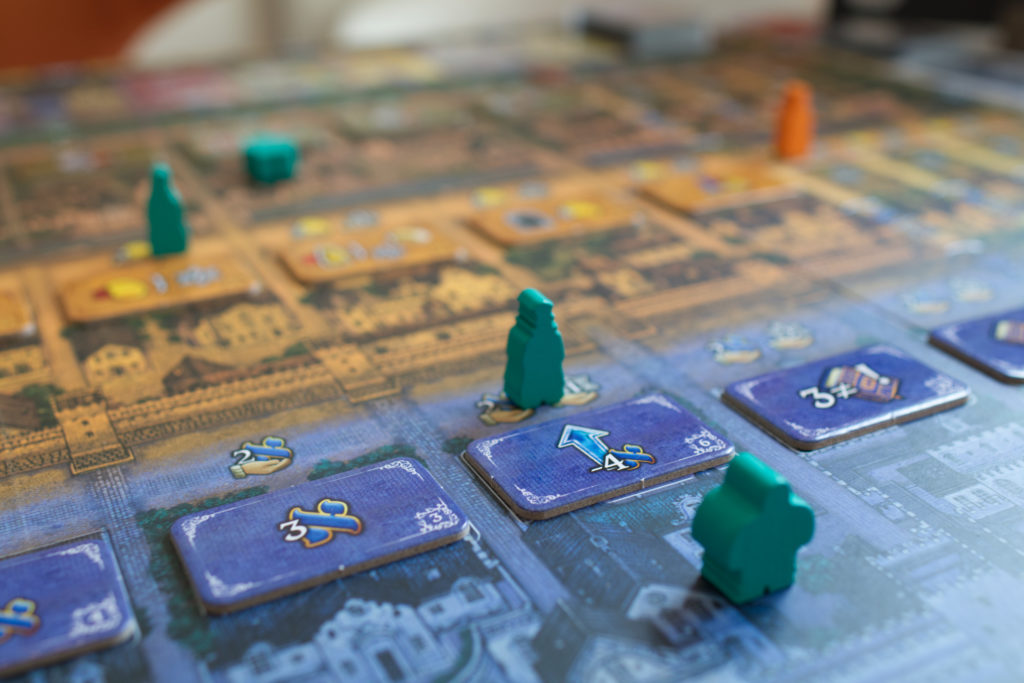
Shared between players is the main action selection mechanism, the Synagogue, a cardboard contraption on top of a plastic tray into which a set of coloured marbles is thrown. This is the party piece of Golem, the thing that literally stands out besides the unusual theme. Next to it, the corresponding small board is placed to indicate which slot belongs to what action. The Synagogue is a rather simple construction and less sophisticated than the cube tower of Shogun/Wallenstein. Throw in the marbles from the top, they bounce around a bit and end up each in one of the five slots. How many marbles of which colour are used is adjusted according to player count. It works better than I thought but not as good as I had hoped. For some reason, the way I throw them in causes fewer marbles to go to the first row and more towards the middle and bottom rows.
The Synagogue board also contains the player order as well as an area for a second action selection mechanism, the Rabbi actions. I’ll go into more details later on, let’s stick with the setup for now as we’re far from done.
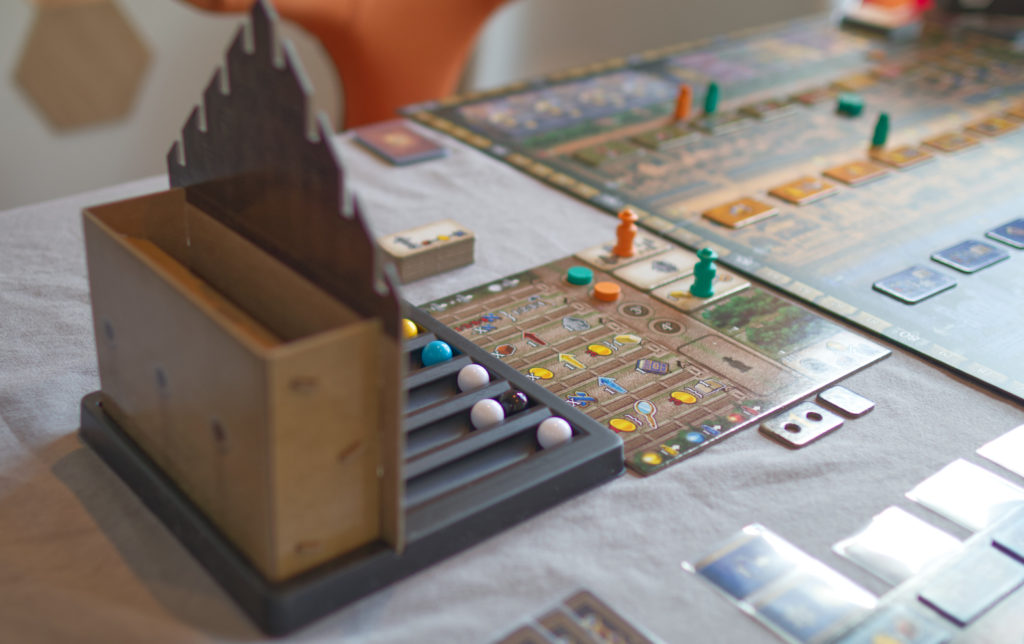
Where things start to get a bit fiddly is that each player gets their own player board plus a bunch of unique upgrade tiles, each of which has a specific place on the board where it has to be placed. Most of the tiles indicate their function and cost on one side and their function plus a Menorah (=candelabrum) on the back. When purchased during the game, one flips them over and they are activated. The artifact-related upgrades work in a completely different way but we’ll skip that for now.
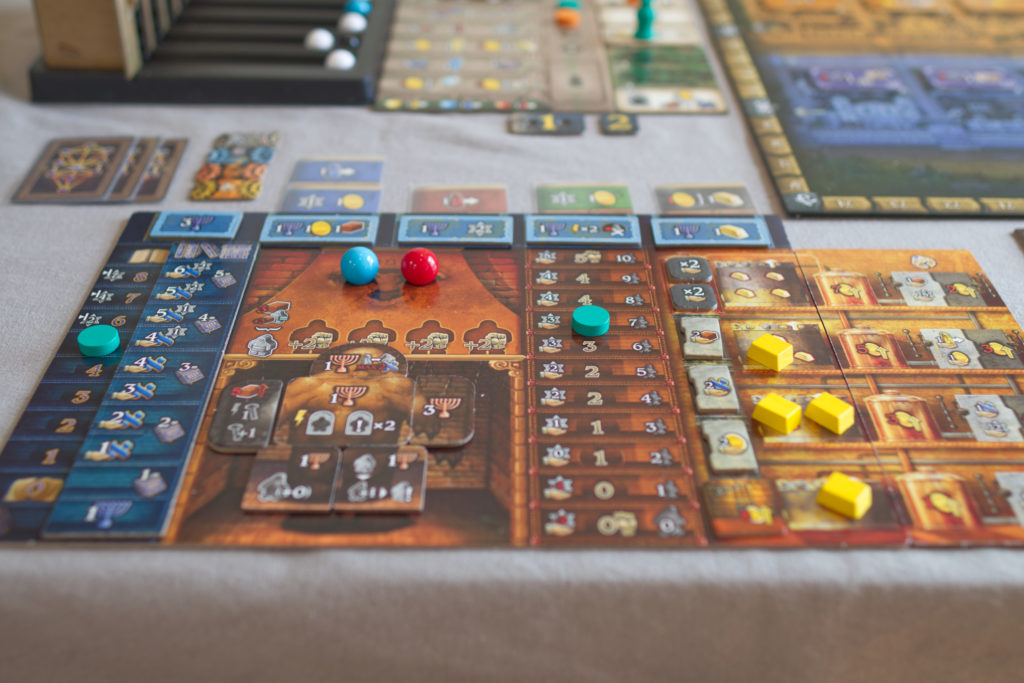
Each player also gets: a couple of wooden pieces, starting tiles (for assigning starting resources), objective cards, a unique artifact board (which is drafted) … let’s just stop right here and sum up: it takes a bit to get oriented and be ready to start.
The Turn
In comparison to the initial setup and teach, the actual round structure is quite simple and flows well: randomise the marbles and do a bit of clean up from the previous round, then the golems move (the game forces you to move them), the players do their turns, and then it’s time for income and paying upkeep for your Golems. Each round, each player will do two marble and one Rabbi action in total. When it’s your turn, you pick an action type (marble/Rabbi), do it and collect all bonuses the action gives you.
When you do a marble action, the color of the marble indicates which of your students moves forward, increasing your income and control over the Golems in that district. The color is also important as you get a reward at the end of the round if you collect a certain combination indicated on the character card for that round at the top of the main board.
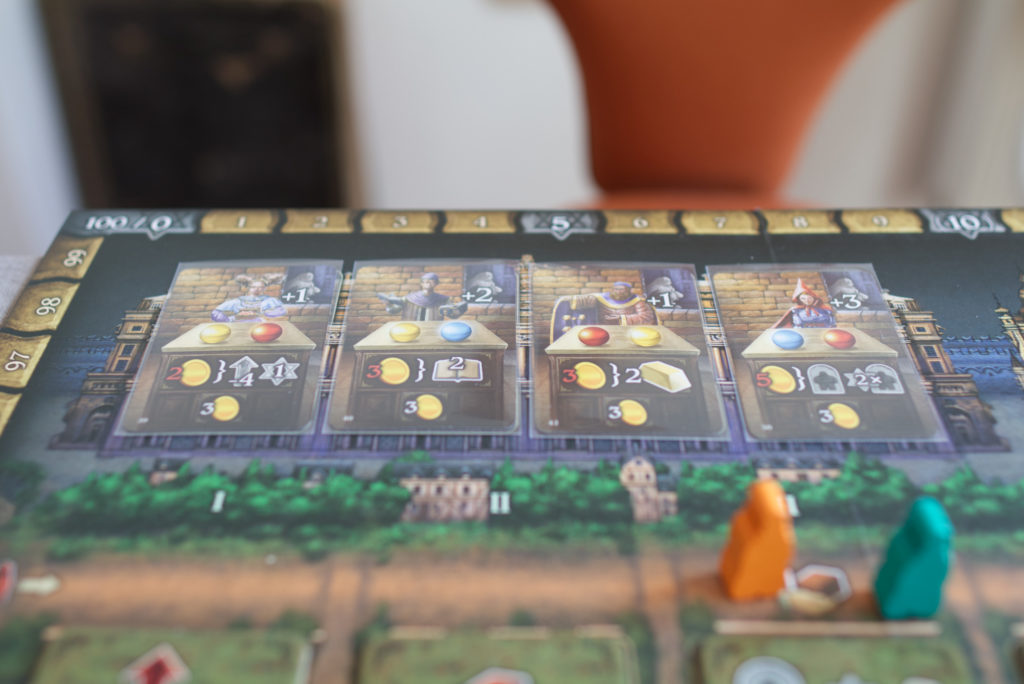
The row you pick the marble from indicates the type of action you can do and the number of marbles in that row with what strength you do it. There are so many different aspects, symbols, and mechanisms at work here that it is difficult to really explain the game without basically reciting the rulebook. So I’ll glossed over a lot of aspects to rather switch to the feel of the game now. On a high level, there are three totally different elements at work here.
One: you can build, upgrade (and destroy) golems. The more golems you have, the faster they run away from you. The greater the distance between your golems and your students, the more knowledge you have to pay as upkeep at the end of the round. The huge benefit of golems is that they continuously produce VPs and when you choose the work action, they will give you lots of bonuses depending on which specific field they currently stand. Note that counter to what you might have learned in other games, golems that travel farther don’t give you more, they just cost you more. Sometimes, there is a great action on the very first field of the district and you’ll want to do whatever you can to prevent that golem from moving. In others, a good action may be some steps further down the district, but then you need to make sure your student catches up or you’ll bleed VP when you cannot pay the upkeep. Upgrading golems will make them stronger, cheaper, more effective and so on. Luckily, there are ways to get rid of your golems if you should lose control and you’ll even get a nice bonus for it.
Two: you can buy books and invest in your research track. Books are bought from a common market using knowledge and slotted above your player board. In each slot, only books of one colour can be placed. Each book gives you a one-time bonus but also an additional bonus that is re-triggered every time you put a new book into the same slot. You need to advance on your research track though as that limits how many books can be in one slot. To make things even more worth your while, you can purchase upgrades which give you yet another additional bonus if you slot in a new book.
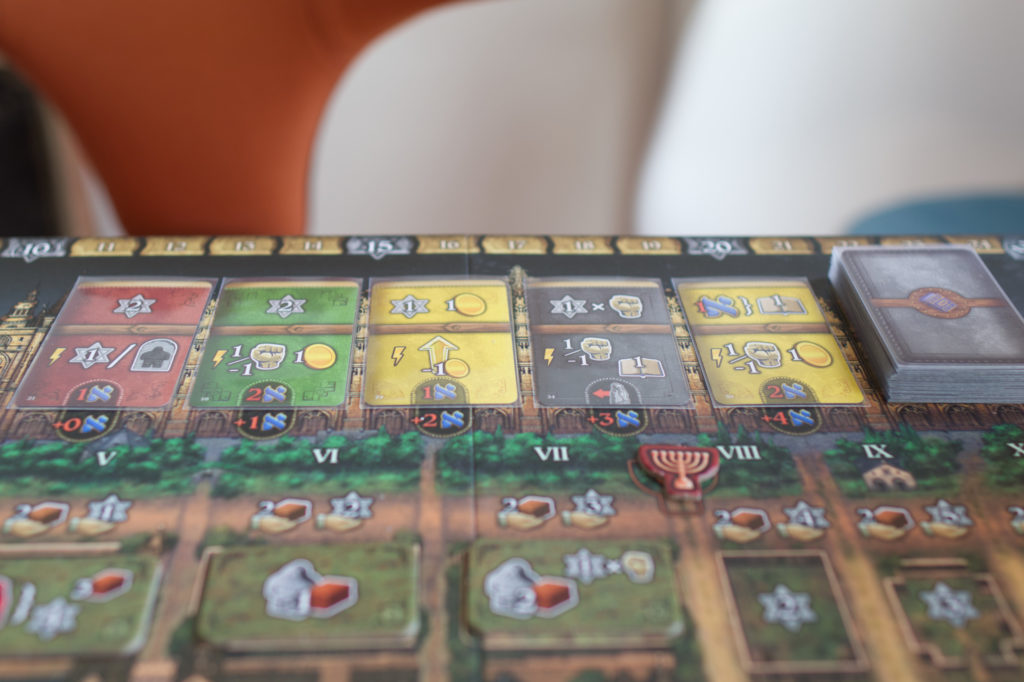
Third: you can gain coin to buy gold and then spend that gold to activate artifacts. There are four with increasing prices from 1 to 4 gold. Once an artifact is activated, it will give you an immediate income and then continue to produce that income at the end of each round (unlike books which only produce when bought). What each artifact produces depends on that unique artifact board you drafted at the start of the game. It can be as simple as a single clay or as good as a free move of one of your students plus another step on your research track. The artifact-related upgrades increase the income of an artifact or allow you to trigger its income while doing something in the middle of the round (e.g. every time you take a red marble).
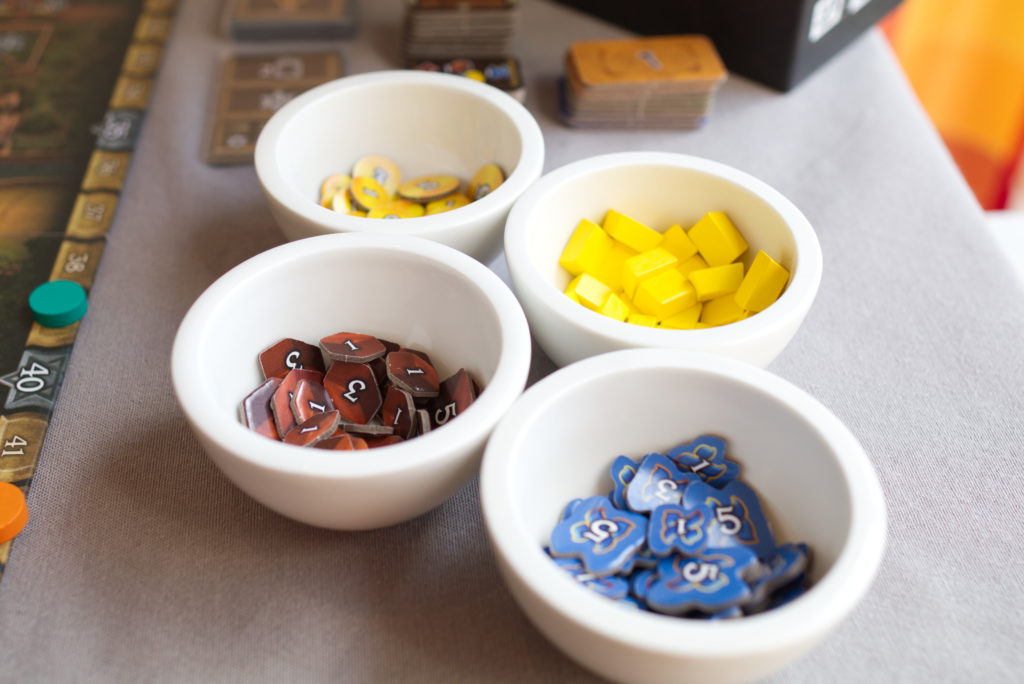
So three is the magic number: there are three different resources (clay, coins, knowledge), three districts, three students, three sets of upgrade tiles, three different mechanisms to get stuff. Similar to Grand Austria Hotel, you only have twelve actions in total for the whole game and have to figure out how you squeeze the most out of them, all while your opponents will likely be interested in the same marbles/actions. You might be able to be more efficient if you do A before B, but maybe B isn’t available anymore once your opponents have done their first action. Also similar to Grand Austria Hotel, you might go in with a plan but if the marbles fall badly for you, the action you had hoped for will have no marble at all and thus not be available or just in a very weak form. You can pass, which means all other players will complete their rounds before you are allowed to do another action, but the benefit is that you can re-throw the remaining marbles and hope for a better distribution.
End of Game
After four rounds, the game ends and you get VP in each of the three different categories: for golems, you get the number of additional golems you have build times the number of red Menorahs you unlocked by purchasing golem-related upgrades. For artifacts, it is the number of activated artifacts times the number of yellow Menorahs from artifact-related upgrades. For books, it is the number of slots you have at least one book in times the number of blue Menorahs from book-related upgrades. Regardless of the category, the maximum is 4 (golems/slots/artifacts) times 8 (a 9th Menorah can be acquired by being the first to push your student to the later fields on the board).
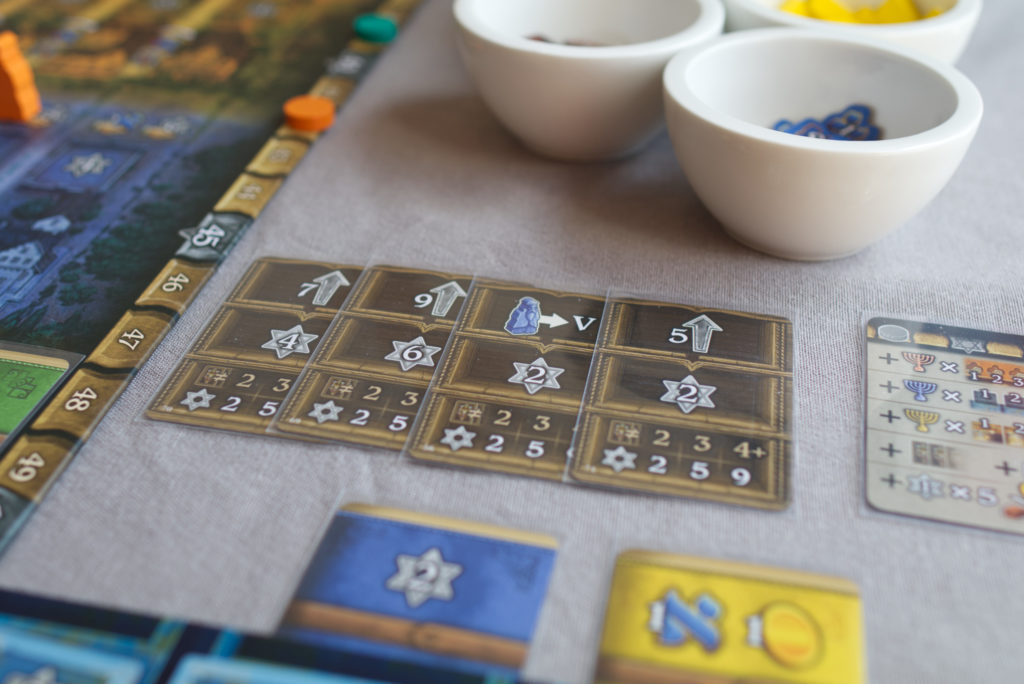
In addition, each player got a number of objective cards at the start of the game such as “gain 6 gold” or “have 9 upgrades” which each produces another 2-6 VP plus a bonus for the number of objectives you have achieved. There are additional sources of VP but those are the big ones.
Solo
Golem comes with an included automa that is quite elaborate (it has it’s own 8 page rulebook) but luckily easy to administer once one gets the hang of it. It acts as a normal player and performs marble/Rabbi actions, moves its golems, has to pay upkeep and so on. The main concession to ease of use is that it only tracks the number of resources it has, not the type. This is done on a small tracker board. It also has a few cardboard chits that indicate the preference the automa has for that game (e.g. artifacts before books before golems).
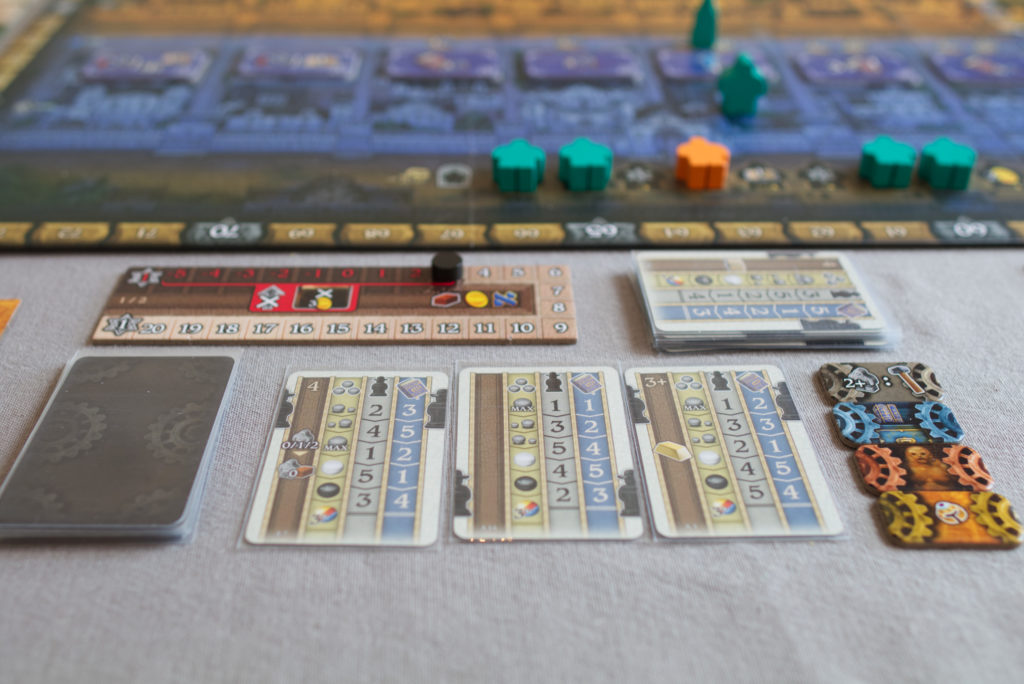
When it’s the automa’s turn, a card is drawn from its deck and that card indicates whether it takes a marble or rabbi action and which one it chooses. It also contains criteria for which marble to pick (e.g. take the left one as indicated on this round’s character bonus card, if multiple possibilities the one from the row with the most marbles, etc).
I think the automa does a very good job of putting pressure on you to carefully consider your timing on which marble to pick when. It tries to collect marble colours to get the character bonus, pick from rows that have the most marbles and keep its golems working. It has a variable preference (sort of strategy), something that a lot of automas are missing, and the production/artwork has been done with care and not as an afterthought (I’m looking at you Red Rising). Since it does the same type of actions you do and has to follow the majority of game rules the same way you do, it is a nice companion for playing Golem on your own or add it as a third/fourth player. There are 4 levels of difficulty which regulate how many starting resources and objectives the automa gets as well as how many additional bonuses it will get during the game. After a few plays, I’ve moved to level 3 and the results are typically within 10VP, which is quite a feat of automa design considering scores are around the 120-140 range (e.g. 131:124, 142:139, 146:142).
Conclusion
Golem is a particular interesting game to discuss because it nicely reflects the evolution of the hobby in recent years. It has its undeniable ancestor in Grand Austria Hotelfrom which it inherits its basic round structure and action selection mechanism. But it draws from so many other games and developments that have come since then. As a result, it much more fits today’s taste of how a board game should work and what players want to see.
There are the starting tiles, which reminded me of the tiles Underwater Cities: New Discoveries introduced to the base game to cut the game length short by one turn. They are both a form of player asymmetry as well as a kickstarter to make even the very first round count already. Objective cards are always great because they give new players a goal to work for while not ruining your game if you don’t fulfil all of them. They reminded me for example of the route cards in The Voyages of Marco Polo. The unique artifact boards also push you in a certain direction. Put together, there is both a lot of randomness hitting you from the very start but also the clear task of forming a strategy how all those pieces (including the distribution of actions in the districts) might fit together.
The marble-action-selection mechanism is an iteration of the dice selection mechanism in Grand Austria Hotel, up to implementing a similar passing-mechanism to remedy unlucky marble distributions. Adding the colours as another dimension is particularly vexing because you need to move those students and the character card bonuses are also too good to not take advantage off. For me personally though, I like the purity of the dice-mechanism in GAH better. In Golem, there are so many considerations going into which marble to choose that it can produce a lot of AP. Do I need to pick a blue to advance my student? But then I won’t get the character bonus this round. So maybe I pick a white but that won’t advance my students. But the blue marbles only are at actions I don’t want to do, so maybe I should rather pick another action that allows me to do what I planned to do although there are more marbles at another action.
This gets even more complex because you have to time when to do the one Rabbi action of your turn. If you do it earlier, you have more choice to pick a good action but the right coloured marbles might be gone. If you do it later, all good Rabbi actions might be taken. And as a side effect, the order of Rabbis will decide the player order in the next round. There is a lot to take into consideration and one inefficient action can make the difference between 120 and 80 VP.
Despite all of this, Golem feels more forgiving to play than Grand Austria Hotel. GAH produces a feeling of “how in the world is it even possible to get there” while Golem is more a “I can do good stuff but I need to do better”. Whatever you do, you get something nice and typically trigger a small combo. Whatever you do, your income gets better from round to round, maybe just not as much as the other players. I was actually surprised how quickly and by what margins our end game scores improved from game to game. Where we were struggling in the first game, we quickly came to a level where each player typically almost maxed out 2 out of the 3 areas. I’m not sure though how much room for improvement is still left. In some parts, it feels like we topped out when it comes to strategy and the improvements we can still make will be dwarfed by the randomness in the game.
Let’s talk about the big one: do I like Golem more than GAH? The answer for me personally is: no. I like the charm of GAH, the somewhat rougher edges, the feeling that after all those plays I had, I still feel like I am a complete rookie. Every time I go into it, I have no idea if I will manage somehow or completely crash and burn because I still have so much to learn. Golem on the other hand feels a bit overburdened with mechanisms and symbology as it is basically 3 different games in one. There are so many different little cogs in this clockwork that it is a wonder they work together that well. It took me quite some time to really grog the rules and feel comfortable playing it. But once I got through the rules, it was rather easy to teach to others. Still, there is a reason why there are multiple pages in the rules that explain all the iconography on the various pieces of cardboard.
Golem also feels rather multiplayer-solitaire to me. Sure, there is interaction when it comes to the marbles and rabbi actions, but there is almost none on the main board. GAH had a similar vibe, but the common pool of guests and milestone goals had me pay way more attention to what my opponent was doing than in Golem. Or maybe it’s that the ratio was higher in GAH. In GAH, there typically is one primary way to do something like readying a room and maybe you can do it as a bonus for a guest or staff card. In Golem there are multiple ways to for example get gold: use the money-action, make a golem work, kill off a golem to get the gold graveyard bonus, activate a new book, activate the slot bonus of the fourth column, fulfil a character bonus, … it just felt that I was so busy with my own problems that I only briefly checked what my opponent might screw up.
But I admit that Golem in many aspects is the more modern and better game. The automa of Golem for example is way better than the one from the Grand Austria Hotel Deluxe Edition and if you are looking for a solo game, I would recommend Golem rather than GAH. It is also easier on new players. Instead of hitting one wall after the other, they simply end up just not getting as many VP as the more experienced players. I asked a friend of mine which of the two games he preferred and he said it’s tough but he leaned toward Golem. This might come with a caveat though: My guess is that Golem is much more satisfying than Grand Austria Hotel for the first 2-3 games but then runs the risk of becoming stale. However, this needs to be put into perspective: we are talking about two very good games from very experienced authors. Both Golem and Grand Austria Hotel punch way above a lot of other games I have played lately.
So will it stay in my collection? To be honest, I’m not sure yet. I really like it as a solo experience but don’t like the theme and dark artwork. The Synagogue feels mechanically flawed and setup is a bit more involved than I would like it to be. There is also something lacking that makes me want to come back for more, but that might be the result of me playing it A LOT in the last couple of days. That said, there are many clever interplays of the mechanisms and once you get through all the rules and iconography, it is a very smooth playing experience. Golem feels worth hanging onto a while longer until I’m really sure what to do. Definitely was worth the purchase and I have multiple people wanting to give it a try!
